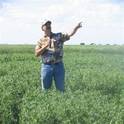Weed control in fallow management to conserve soil moisture and nutrients is the largest variable cost to dryland grain production. Our objective was to compare burning, grazing, tilling, trampling and clipping wheat stubble fields on changes in total above ground biomass and weed density. Treatments were evaluated in three experiments using a randomized complete block design for each experiment with four replications at each site. Contrasts statements were used to make pre-planned comparisons. For experiment 1, treatments were fall tilled, fall grazed, spring grazed, fall and spring combined (Fall/Spr) grazed, and an untreated control. For grazing treatments, five mature ewes were confined with electric fence to 111 m2 plot for 24 h for fall and spring resulting in a stocking rate of 452 sheep day/ha. For Fall/Spr the stocking rate was 904 sheep day/ha. For experiment 2, treatments were fall grazed, fall burned, fall tilled, and an untreated control. In experiment 3, treatments were fall trampling by sheep, spring trampling by sheep, fall and spring combined (Fall/Spr) trampling by sheep, stubble hand clipped to a height of 4.5 cm, and an untreated control. Trampling treatments were applied at the same stocking rates as grazing treatments but sheep were muzzled to prevent intake. Data were collected in the fall, prior to treatment imposition, and spring, after treatments had been removed. Post treatment biomass and weed density were greater (P < 0.05) in either control or tilled plots when compared to grazed plots. Post treatment biomass and weed density were greater (P < 0.01) for control than burned plots. Post treatment biomass, weed density, and percent change in these variables, did not differ (P > 0.08) between burned and tilled, and burned and grazed treatments. These results indicate the potential for using grazing sheep as a component in fallow management to reduce biomass and control weeds.
- Fallow management,
- Weed control,
- Sheep grazing,
- Tillage,
- Burning,
- Trampling
Available at: http://works.bepress.com/andrew_lenssen/53/
